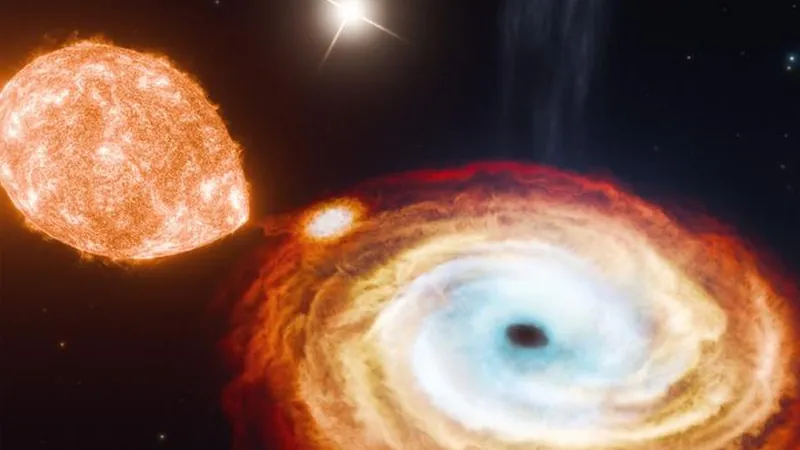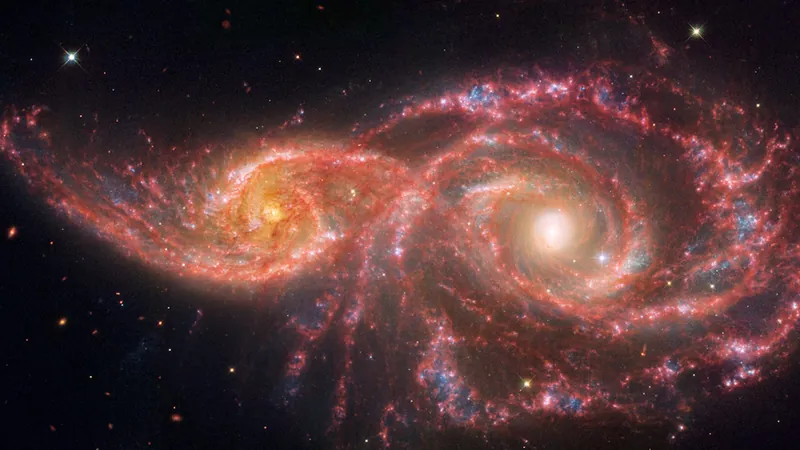
Groundbreaking Discovery of the Universe's First 'Black Hole Triple' System Shatters Our Understanding of Cosmic Births!
2024-10-25
Author: Daniel
Introduction
Astronomers have stumbled upon a groundbreaking revelation in the cosmos: the first-ever known "black hole triple" system, showcasing a dark black hole orbited by not one, but two stars! This unprecedented configuration challenges everything we believe about how these incredible singularities come into being.
Historical Context
Historically, most of the black holes we've identified—except for the magnificent supermassive ones at the centers of galaxies—are found existing in binary systems. These binaries typically involve a black hole orbiting another massive entity, such as a star or neutron star. This is due in part to the fact that these mysterious cosmic voids are much easier to detect when they’re exerting gravitational influence on nearby objects.
The Groundbreaking Study
However, a new study published on October 23rd in the esteemed journal *Nature* reveals something astonishing. Researchers examining the well-known binary system comprising the black hole V404 Cygni, which has long been known to feast on a nearby star, made a startling observation—there is a second star in orbit, positioned at a staggering distance from the pair.
Revolutionary Theory on Formation
Gravitational calculations provide compelling evidence that this newfound star could not have persisted in its distant orbit if V404 Cygni had originated through a supernova explosion. The shockwaves from such an explosion would have easily displaced it, but researchers propose a revolutionary alternate theory: this black hole likely formed from the gradual collapse of a third, massive star that once anchored the other two.
Expert Insights
Lead author Kevin Burdge, a prominent astrophysicist at MIT, expressed his enthusiasm about this revelation, stating, "This discovery is super exciting for black hole evolution! We’ve always thought that most black holes arise from cataclysmic stellar explosions, but this find calls that belief into serious question."
About V404 Cygni
V404 Cygni, the black hole at the heart of this fascinating triad, boasts a mass roughly nine times that of our sun and is located about 8,000 light-years from Earth in the Milky Way. It holds the remarkable distinction of being one of the first black holes discovered back in 1992, and its nearby star—consumed through gravitational attraction—cycles around it every 6.5 days.
The Discovery Process
The researchers were taken aback during a recent reexamination of V404 Cygni images, part of a broader survey of black holes in our galaxy. They identified the elusive second star orbiting at a distance of approximately 3,500 astronomical units—around 90 times farther away than Pluto's orbit. In fact, it likely takes this newly confirmed star an astounding 70,000 years to complete one orbit around V404 Cygni.
Synchronization of Stars
After monitoring the movement of both stars over the past decade, the team found that they moved in perfect synchrony, proving their gravitational bond to each other, as well as to V404 Cygni. The odds that the two stars’ coordinated movement is simply a coincidence are about 1 in 10 million, leading researchers to conclude that they form a genuine triple system.
Significance of the Findings
"This is almost certainly not mere coincidence or accident," Burdge proclaimed. "We are observing two stars attached through a delicate gravitational connection—their movement proves this is indeed a triple celestial system."
Distinction from Previous Findings
Interestingly, this isn’t the first time astronomers thought they had uncovered a black hole triple system. In 2020, a proposed system just 1,000 light-years away appeared to show a black hole surrounded by two stars, only for further investigation to reveal it was actually a binary system composed of a black hole and a "vampire star," which drains gas from a smaller companion.
Implications for Black Hole Research
This groundbreaking discovery raises exhilarating questions about black hole formation. If V404 Cygni indeed formed through the gradual collapse as suspected, it might have originated within the last 4 billion years—an era filled with immense cosmic phenomena and stellar evolution. This groundbreaking discovery not only redefines our understanding of black holes but also opens the door to new research and deeper insights into the mysteries of our universe!

 Brasil (PT)
Brasil (PT)
 Canada (EN)
Canada (EN)
 Chile (ES)
Chile (ES)
 España (ES)
España (ES)
 France (FR)
France (FR)
 Hong Kong (EN)
Hong Kong (EN)
 Italia (IT)
Italia (IT)
 日本 (JA)
日本 (JA)
 Magyarország (HU)
Magyarország (HU)
 Norge (NO)
Norge (NO)
 Polska (PL)
Polska (PL)
 Schweiz (DE)
Schweiz (DE)
 Singapore (EN)
Singapore (EN)
 Sverige (SV)
Sverige (SV)
 Suomi (FI)
Suomi (FI)
 Türkiye (TR)
Türkiye (TR)